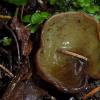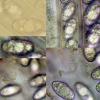
31-08-2010 01:53
 Björn Wergen
Björn Wergen
Hi, I have found this small Peziza directly by

30-08-2010 09:29
Marja PennanenHello, this should have been a breakable mystery,

30-08-2010 09:14
Marja PennanenHello, as I mentioned I found something on the ne

30-08-2010 08:30
Marja PennanenHello, yesterday I studied part of my new finding

29-08-2010 11:43
Marja PennanenHello, in spite of huge amounts of unfinished spe

28-08-2010 21:42
Trouvé dans une rivière ardennaise lors des JME.

27-08-2010 13:59
Marja PennanenNow, that I learned the shape of the spores H. sc
Peziza badiofuscoides or badia?? or what? need help
Björn Wergen,
31-08-2010 01:53
 Hi,
Hi,I have found this small Peziza directly by a little river in a coniferous forest. Because of my interest in collecting operculate ascomycetes growing on soil I tried to determine this one as usual, but there is a problem I hope to get solved here ;)
Along the keys to Peziza species, you will end at Peziza badiofuscoides, but my problem is the spore size: 17-18,5x9,5-10 µm. It does not fit well to P. badiofuscoides, but the more to Peziza badia. The problem here are the size of the fruitbodies (< 50 mm!) and the spores, containing only one big guttule or one big guttule and a second one with lower size. That does not also fit well to Peziza badia...
Are there any other species with olivebrown fruitbodies and "one-guttuled-spores" with a complete reticulum? If there are more details needed, I will try to describe it here, I am still sorry for my bad english and more for my not existing french ^^
cheers,
bwergen
Björn Wergen,
31-08-2010 01:55
Nicolas VAN VOOREN,
31-08-2010 07:41

Re:Peziza badiofuscoides or badia?? or what? need help
I think it's P. badia, the features of the spores that you show are good for this species.
Alain BRISSARD,
31-08-2010 12:09
Re:Peziza badiofuscoides or badia?? or what? need help
I think so it's P. badia (CF. les spores irrégulièrement réticulées à observer dans le bleu coton).
The features of the fruitbody is so possible
The features of the fruitbody is so possible
Björn Wergen,
01-09-2010 16:46

Re:Peziza badiofuscoides or badia?? or what? need help
Thank you very much for your help ;)
cheers, bwergen
cheers, bwergen
Mario Filippa,
06-09-2010 15:39
Re:Peziza badiofuscoides or badia?? or what? need help
I don't have literature available now, but check Peziza limnea also.
Regards
Mario
Regards
Mario



